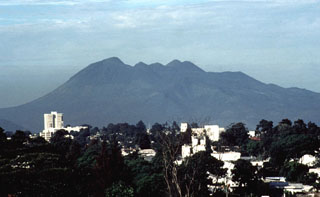Report on Pacaya (Guatemala) — February 1990
Bulletin of the Global Volcanism Network, vol. 15, no. 2 (February 1990)
Managing Editor: Lindsay McClelland.
Pacaya (Guatemala) Renewed explosive activity builds new cone
Please cite this report as:
Global Volcanism Program, 1990. Report on Pacaya (Guatemala) (McClelland, L., ed.). Bulletin of the Global Volcanism Network, 15:2. Smithsonian Institution. https://doi.org/10.5479/si.GVP.BGVN199002-342110
Pacaya
Guatemala
14.382°N, 90.601°W; summit elev. 2569 m
All times are local (unless otherwise noted)
Activity had been limited to degassing from fumaroles since the March 1989 eruption. Moderate steam emissions and a rumbling noise were noted during a summit climb on 29 November. Deep rumbling noises and a weak red glow within the crater were reported by nearby residents at the beginning of January, and geologists observed gas bursts and Strombolian spattering during 4 January fieldwork. Observation trips on 27 January and 4 February revealed a growing cone on the floor of MacKenney Crater, with intermittent explosive activity that occurred every 2-5 minutes.
Geological Summary. Eruptions from Pacaya are frequently visible from Guatemala City, the nation's capital. This complex basaltic volcano was constructed just outside the southern topographic rim of the 14 x 16 km Pleistocene Amatitlán caldera. A cluster of dacitic lava domes occupies the southern caldera floor. The post-caldera Pacaya massif includes the older Pacaya Viejo and Cerro Grande stratovolcanoes and the currently active Mackenney stratovolcano. Collapse of Pacaya Viejo between 600 and 1,500 years ago produced a debris-avalanche deposit that extends 25 km onto the Pacific coastal plain and left an arcuate scarp inside which the modern Pacaya volcano (Mackenney cone) grew. The NW-flank Cerro Chino crater was last active in the 19th century. During the past several decades, activity has consisted of frequent Strombolian eruptions with intermittent lava flow extrusion that has partially filled in the caldera moat and covered the flanks of Mackenney cone, punctuated by occasional larger explosive eruptions that partially destroy the summit.
Information Contacts: A. MacKenney, Guatemala City.

